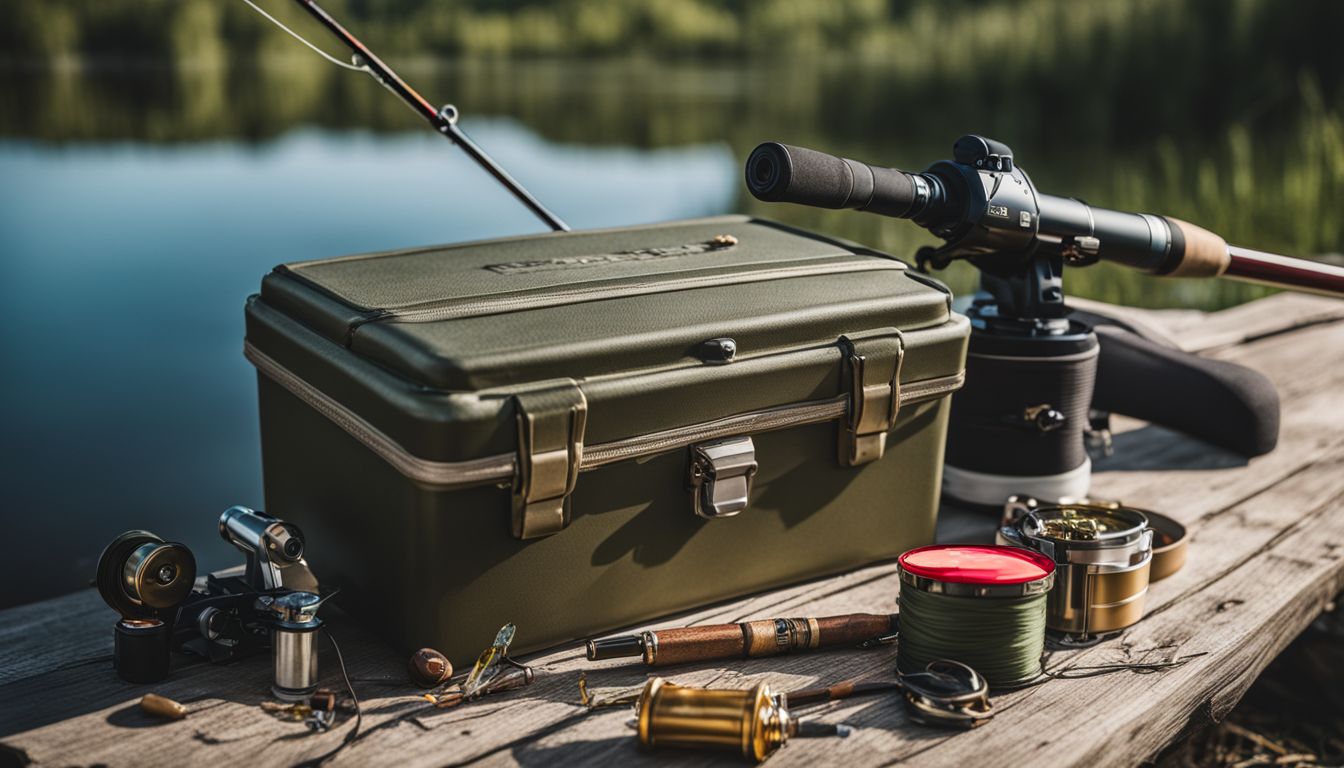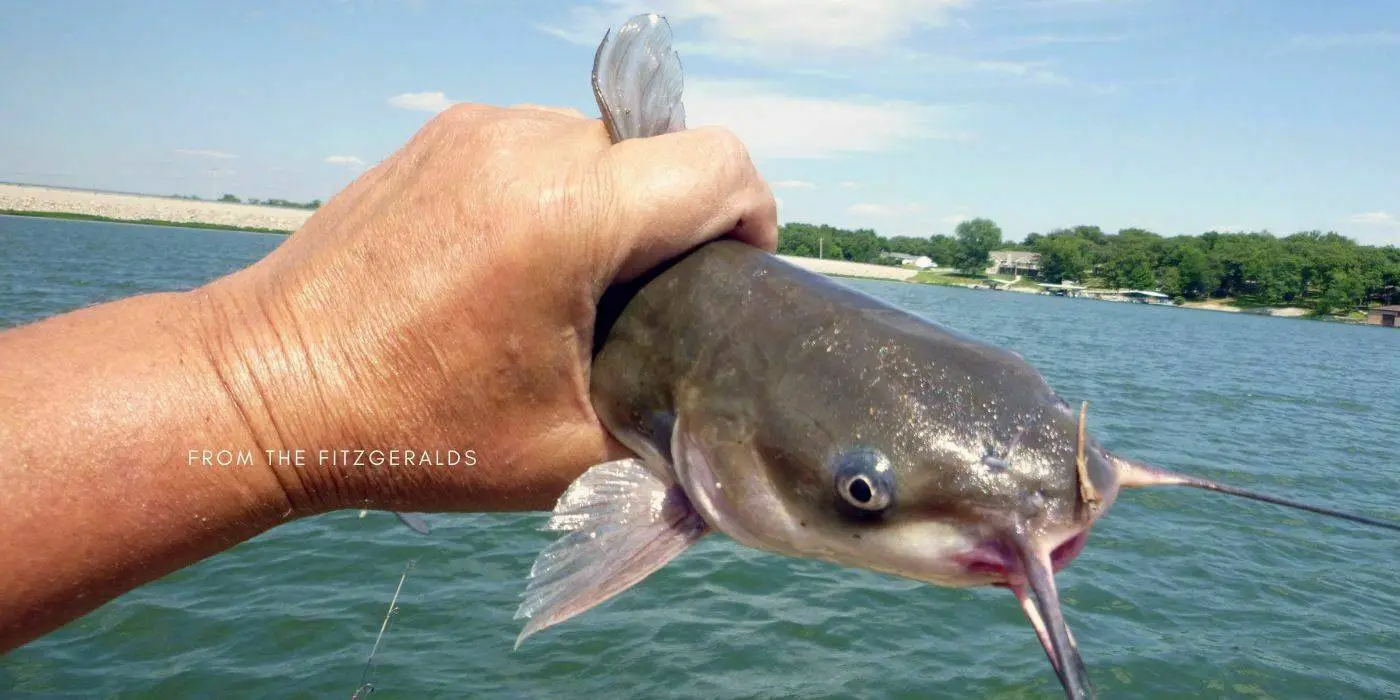Do you find yourself daydreaming about reeling in a giant whiskered beast of a catfish, only to be met with empty lines and disappointment? I completely understand your frustration; these elusive river dwellers can indeed put up quite the challenge.
With their unique traits across different species, hooking one often seems like solving an aquatic puzzle. Yet, after countless hours spent studying these intriguing creatures and getting my hands wet – literally and figuratively – I’ve unearthed some real game-changing strategies.
It’s time to turn fishing fantasies into reality with this Ultimate Guide: How to Fish for Catfish. Let’s dive together into an ocean of knowledge!
Key Takeaways
- Different types of catfish, such as flathead, blue, and channel, have their own habits and preferences for habitat and bait.
- The best time to catch catfish is during the warmer months, with late March to early May being optimal.
- Having the right gear, including strong rods and reels, appropriate baits or lures, as well as essential accessories like hook removers and fish grippers is important for successful catfishing.
- To catch catfish from shore or a boat, knowing the right techniques such as bottom bouncing or using heavy rigs can increase your chances of landing big ones.
Where and When to Catch Catfish

To have the best chance of catching catfish, it’s important to know where and when they are most active. Different types of catfish can be found in various habitats, including lakes, rivers, and ponds.
Flathead catfish prefer deep holes with plenty of cover, while blue and channel catfish are often found near structures like fallen trees or rocky areas. As for timing, catfish tend to feed more actively during the warmer months, especially early morning or late evening.
Nighttime fishing can also be incredibly productive as catfish are nocturnal creatures.
Types of Catfish: Flathead, Blue, and Channel
Flathead, blue, and channel catfish are the top three types. Flatheads live alone and can be hard to catch but offer a fun challenge. Blue catfish like different waters. They don’t mind saltier rivers and lakes.
Channel catfish often swim together in groups known as schools. These are the most hunted kinds of catfish in the U.S.! Each one has its own habits and homes that make fishing for them a great adventure!
Best Time for Catfishing
Catch a lot of catfish in late March, April, and early May. These are great times to fish for big blue catfish! The water starts to warm during spring. The warmer water is perfect for all kinds of catfish.
Catfish like to spawn when the water hits 70°F to 75°F. That’s why spring is such a good time for fishing.
You can catch catfish any hours of the day but they like lowlight and night hours more. Catching them in different spots at sunrise or after dark works well too, especially in summertime! Overnight fishing can be fun and rewarding because cats stay active even then.
Daytime vs. Nighttime Catfishing
Day or night, catfish are always ready to bite! Many think you can only catch them at night. That’s not true! These fish eat all day too. Still, they do like the dark hours and places with a lot of things in the water nearby deeper areas.
During the day, these spots change. But don’t worry! You can still catch plenty of catfish when the sun is up. It just takes knowing where to look and using smart tactics. So whether it’s day or night, with patience and strategy, your fishing trip can be a hit any time!
Best Season for Catfishing
Late March, April, and early May are some of the best times for catfishing, especially if you’re targeting big blue catfish. Spring is an ideal fishing season because the water starts to warm up, making the fish more active.
However, you can catch catfish throughout the year. Generally, from early spring to summer is prime time for catfishing, but they can be caught year-round. The best fishing times can vary depending on your location and whether you’re fishing in rivers or lakes.
So get ready to reel in those trophy-worthy catfish!
Essential Catfish Gear

To successfully catch catfish, you’ll need the right gear – from sturdy rods and reels to effective baits and lures. Don’t miss out on this essential information!
Rods and Reels
When it comes to catfish fishing, having the right rods and reels is crucial. You want something strong and durable that can handle the weight of those big catfish. I recommend using a 6- to 7-foot, medium-heavy spinning rod paired with a reel spooled with 14-pound or stronger abrasion-resistant monofilament line.
This combination will give you the strength and control you need to reel in those monster catfish.
If you’re looking for even tougher options, there are heavy-duty catfish rod and reel combos available. These are made specifically for handling larger fish and can withstand some serious fighting power.
Team Catfish offers some great options for those who want something extra durable.
Don’t forget about your terminal tackle either! Having the right hooks, sinkers, and swivels is essential for catfish fishing success. Make sure to choose sizes that match the type of catfish you’re targeting and the conditions of your fishing spot.
Baits and Lures
When it comes to catfish fishing, choosing the right bait is crucial. There are several baits that work well for catfish, including nightcrawlers, leeches, chicken blood, chicken liver, fish guts, crawdads, grasshoppers, water dogs and live or dead minnows.
Each type of bait attracts different types of catfish. For example, flathead catfish are known to be attracted to live bluegill as bait. Experiment with different baits to see what works best for you and the type of catfish you want to catch.
Other Essential Accessories
When it comes to catfishing, there are a few other essential accessories that can make your fishing experience more enjoyable and successful. One important accessory is a hook remover, which helps safely remove hooks from the mouths of catfish without harming them or yourself.
Another handy tool is a fish gripper, which allows you to handle and control the catfish during the landing process. A landing scoop or net scooper is also useful for easily scooping up the catfish once it has been reeled in.
Additionally, having a good pair of angler scissors or line cutters can come in handy for cutting fishing line and other materials while on the water. Lastly, it’s always helpful to have a weight scale with you so that you can accurately measure the weight of any catfish you catch.
How to Catch Catfish: Step-by-Step Guide
To catch catfish, start by choosing the right fishing spot and bait. Next, cast your line out and wait for a bite. Once you feel a tug on your line, set the hook firmly by reeling in quickly.
Then, use steady pressure to reel in the catfish while keeping tension on the line. Finally, carefully lift the catfish out of the water and unhook it using pliers or a dehooking tool.
Bank Fishing Techniques
I’m excited to share some bank fishing techniques that will help you catch catfish from the shore. As a fellow angler, I’ve learned a few tricks over the years that have proven successful for me.
First and foremost, it’s important to choose the right spot along the bank. Look for areas with cover such as fallen trees or vegetation where catfish like to hide. Cast your line near these spots to increase your chances of hooking a fish.
When it comes to bait, using something strong-smelling like chicken liver or worms can attract hungry catfish. Make sure your bait is secure on your hook so it doesn’t easily come off when casting or fighting a fish.
Another technique that works well is called “bottom bouncing.” This involves casting your line out and allowing it to sink until it touches the bottom. Then slowly reel in while keeping tension on your line.
This motion mimics natural movement and entices catfish to bite.
Boat Fishing Techniques
When it comes to catfish fishing, using a boat can be an effective method. To catch catfish from a boat, I recommend using heavy rigs and selecting the right bait for the type of catfish you want to target.
It’s also a good idea to try different bait on each rod to see what works best. Whether you’re fishing from the bank or a boat, using a simple bait rig can help attract those elusive catfish.
And don’t worry if you don’t have access to a boat – you can still fish for catfish effectively from shore! Just follow some tips and techniques for casting your line out far enough and using the right gear.
Tips for Targeting Big Catfish
When targeting big catfish, it’s important to use the right techniques and gear. One tip is to use heavy rigs that can handle their strong fighting abilities. Another tip is to try different bait on each rod to determine what works best for attracting catfish.
Worms and chicken liver are effective baits that you can use. When fishing in a body of water with little current or using a big bait, it’s recommended to use bigger egg sinkers up to 1 ounce.
By following these tips, you’ll have a better chance of landing those big catfish you’re after.
How to Skin and Clean Catfish
Cleaning and preparing catfish is an important part of the fishing process. Here’s how to skin and clean catfish:
- Acquire a catfish by either catching it yourself or purchasing it from a market.
- Once you have the catfish, you’ll need to kill it quickly and humanely. You can do this by cutting through the spine just behind the head.
- Cut around the head of the catfish, making sure to remove it completely.
- Next, remove the fins by cutting them off close to the body.
- Use a pair of pliers or fish skinners to peel away the tough outer skin of the catfish. Start at the tail and work your way towards the head.
- After removing the skin, make an incision along the belly of the fish from its anus to just below its jaw.
- Carefully remove all of the internal organs and entrails from inside the fish, being sure not to puncture any organs in the process.
- Rinse out any remaining blood or residue from inside the fish with cold water.
- If desired, you can soak the cleaned fish in a mixture of water and vinegar for about 30 minutes to help remove any lingering fishy taste.
- Rinse off any excess vinegar thoroughly before cooking or freezing your cleaned catfish.
How to Distinguish and Catch Different Types of Catfish
Learn how to identify blue and channel catfish, discover the best baits for each type, and master the techniques for catching flathead, blue, and channel catfish. Ready to reel in the big ones? Keep reading!
Identifying Blue and Channel Catfish
Blue catfish and channel catfish are two common types of catfish that anglers encounter. Blue catfish are native to the Red River watershed and are considered a trophy catch. They have a bluish coloration, making them easy to distinguish from other types of catfish.
On the other hand, channel catfish are the second most frequently caught fish in North America. They have a grayish body with dark spots. It’s important to be able to identify these two species because they have different biology, including habitat requirements, diet preferences, and distribution patterns.
Being able to recognize blue and channel catfish will help you know which baits and techniques work best for each type when you’re out on your fishing adventure.
Best Baits for Each Type
When it comes to catfish, different types of bait work best for each species. For flathead catfish, live bluegill bait is a top choice. They are attracted to the movement and scent of live fish.
Blue catfish, on the other hand, prefer natural baits like cut shad or skipjack herring. These baits release oils and scents that entice them to bite. Finally, channel catfish can be caught using a variety of baits such as chicken liver, stinkbaits, or dough baits.
The strong smells from these baits will attract their attention. So when you’re out fishing for catfish, make sure you have the right bait for the type you want to catch.
Techniques for Catching Flathead, Blue, and Channel Catfish
As an angler, I have learned valuable techniques for catching flathead, blue, and channel catfish. Here are some tips to help you land these different types of catfish:
- Use sturdy gear: When targeting flathead catfish, use heavy-duty rods and reels, as they can grow quite large. For blue and channel catfish, medium-heavy to heavy rods will do the trick.
- Bait selection: Flathead catfish are known for their preference for live bait such as small fish or large nightcrawlers. Blue catfish are often caught using cut bait like shad or skipjack herring. Channel catfish are less picky and will go after a variety of baits including worms, stink bait, or chicken liver.
- Location matters: Flathead catfish prefer larger rivers and reservoirs with deep holes or structures like fallen trees or rock piles where they can hide during the day. Blue and channel catfish can be found in various habitats such as rivers, lakes, and even ponds.
- Bottom fishing technique: When targeting flathead, blue, or channel catfish from the shore (bank fishing), try bottom fishing with a sliding sinker rig. This allows your bait to rest on the bottom where these species typically feed.
- Patience is key: Catfish tend to be more active during dawn and dusk when they come out to search for food. It’s best to plan your fishing trips around these times for higher chances of success.
Pro Tips and Resources for Catfish Fishing
Discover the top charters and locations for catfish fishing, stay updated with the latest gear and tackle reviews, learn how to set and adjust drag like a pro, find out how to make your own lures, and explore other helpful fishing tips and videos.
Top Charters and Locations
If you’re looking for the best catfish fishing spots, there are some top charters and locations that I recommend. In Iowa, you’ll find plenty of game fish like channel catfish in lakes, ponds, streams, and rivers.
They’re everywhere! Missouri is also a great place to catch catfish because they can be found in publicly owned lakes, private ponds, and streams. If you prefer online fishing resources or want tips for catching catfish from the bank in a lake or at specific times in rivers or lakes – I’ve got you covered with those too.
Latest Catfish Gear and Tackle Reviews
I love staying updated with the latest catfish gear and tackle reviews. It helps me make informed decisions about my fishing equipment. From professional catfish rods to innovative lures, there is always something new and exciting in the market.
Reading these reviews not only gives me insights into the performance of different gear options but also provides recommendations from experienced anglers. I find it helpful to know what works best for catching those big catfish and improving my overall fishing experience.
Remember, having the right gear can greatly impact your success on the water!
Advice for Setting and Adjusting Drag
Properly setting the fishing reel drag is super important when you’re out catfish fishing. The drag on your reel lets it slip a bit so that it can compensate for the fish pulling. It’s good to have some tension, but not too much that the line breaks easily.
You want to find that sweet spot where it’s strong enough to handle a big catfish, but also gives the fish some room to fight and tire itself out. Experiment with different drag settings until you find what works best for you.
And don’t forget, always adjust the floatstop if you’re using bait that moves around a lot – this will help attract those hungry catfish!
How to Make Your Own Lures
Making your own lures can be a fun and effective way to catch catfish. Here are some tips and resources to help you get started:
- Use scented materials: Adding scents to your homemade lures will attract catfish even more. Consider using ingredients like garlic, shrimp, or liver to enhance the scent.
- Get creative with materials: You can use various materials like feathers, rubber skirts, or soft plastics to create your own unique catfish lures. Experiment with different colors and textures to see what works best.
- Research different lure designs: Look for online tutorials or videos that show different lure designs specifically for catfish fishing. These resources can guide you in creating effective lures based on the catfish species you’re targeting.
- Test your lures: Once you’ve made your homemade lures, take them out on the water and test their performance. Pay attention to how they move in the water and if they attract any bites from catfish.
- Learn from experienced anglers: Join online fishing forums or connect with fellow anglers who have experience in making their own lures for catfish fishing. They can provide valuable insights and tips to improve your lure-making skills.
Other Helpful Fishing Tips and Videos
I’ve got some more helpful tips and videos to make your catfishing experience even better. Here are some things you can try:.
1. Use the right fishing line: For catching catfish, it’s best to use a strong monofilament or braided line that can handle their size and strength.
2. Experiment with different baits: While worms and liver are popular choices, don’t be afraid to try other baits like live minnows, shrimp, cut bait, or stink bait. Different catfish species may prefer different types of bait.
3. Fish in wooded areas: If you’re targeting flathead catfish with a rod and reel, look for heavily wooded areas such as coves or backwaters with high fish density. These spots can increase your chances of landing the big ones.
Conclusion
In conclusion, this ultimate guide provides you with all the information you need to fish for catfish and land that big one. From knowing where and when to catch catfish, to essential gear and step-by-step techniques, you’ll be equipped to reel in those impressive catches.
With expert tips and resources, you can take your catfishing game to the next level. So grab your gear, head out on the water or bank, and get ready for an exciting catfishing adventure!
FAQs
1. What bait should I use to catch catfish?
You can use a variety of baits to catch catfish, such as worms, shrimp, chicken liver, or prepared bait designed specifically for catfish.
2. Where is the best place to fish for catfish?
Catfish tend to hide in deep holes or areas with underwater structures like fallen trees or rocks. Look for these spots in rivers, lakes, or ponds to increase your chances of catching catfish.
3. What type of fishing rod and reel should I use for catfishing?
A medium-heavy spinning rod and reel combo is suitable for most catfishing situations. Make sure it has sufficient line capacity and a strong drag system to handle the power of a big catfish.
4. How do I properly land a big catfish once I’ve hooked it?
When you have hooked a big catfish, play it patiently and avoid rushing the process. Use a landing net to safely bring the fish close enough to shore before carefully lifting it out of the water.
5. Are there any regulations or licenses required when fishing for catfish?
Yes, regulations and license requirements differ depending on your location and specific body of water where you plan to fish. Check with local authorities or visit their website for information on fishing licenses and any specific regulations regarding catching catfish




